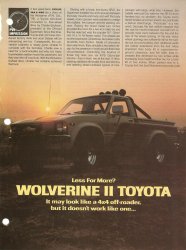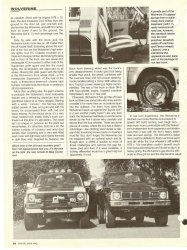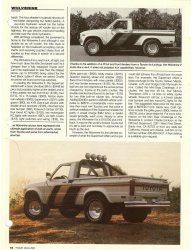Had a little time on my hands and decided to make another Toyota history post.
This ones about Toyota trucks and hopefully has some interesting info for all you Toyota lovers.
Toyota Hilux
Manufacturer:
Toyota Motor Corporation
Toyota Motor Argentina S.A.
Toyota Motor Thailand Co., Ltd.
Guangqi Toyota Automobile
Hino Motor
NUMMI (1991-1995: North America)
(Toyota pickup or Delux pickup in North America)
Production:
1968–present
Predecessor:
Toyopet Light (Stout)
Hino/Toyota Briska
Successor:
Toyota Tacoma (Japan and North America)
Hilux name remains in use in other parts of the world
Toyota Hilux is a series of compact pickup trucks produced and marketed by the Toyota Motor Corporation. Most countries used the Hilux name for the entire life of the series in North America, the Hilux name was retired in 1976 in favor of Delux, Truck, Pickup Truck, or Compact Truck. In North America the popular option package, the SR5 (Sport Rally 5-Speed), was used as a model name for the truck, even though the option package was also available on other Toyota models. In 1984, the Trekker, a camper version of the Hilux, was renamed as the 4Runner in Australia and North America, and as the Hilux Surf in Japan. In 1996, Toyota introduced a new pickup model, the Tacoma in North America, discontinuing the Hilux/Delux/Pickup there. The 4Runner is now a full SUV, and the more recent models do not resemble the Tacoma as closely as they once did.
Hilux truck production:
Mar 1968–Apr 1972
Assembly origin:
Hamura, Tokyo, Japan
Available Engines:
1,490 cc 2R I4
1,587 cc 12R I4
1,858 cc 8R I4
1,897 cc 3R I4
1,968 cc 18R I4
Transmission:
4-speed manual
The Hilux started production in March 1968 as the RN10 in short-wheelbase form with a 1.5 L engine, producing 77 PS (57 kW) in Japanese market spec, and in Japan it was available at Toyota Japan dealership retail chains named Toyota Store and Toyopet Store. The modification to the engine was enough for a claimed 130 kilometres per hour (81 mph) top speed. This was upgraded to a 1.6 L I4 engine in February 1971.
In April 1969, a long-wheelbase version was added to the range. The short-wheelbase version also continued in production for many more years. The long-wheelbase version was not sold on the North American market until 1972.
In spite of the name "Hilux", it was a luxury vehicle only when compared to the Stout. The Hilux was engineered and assembled by Hino Motors to replace the earlier vehicle that the Hilux was derived from, called the Briska in the niche beneath the larger Stout, it replaced the Stout fully in some markets. For the North American market, the only body style was a regular cab short bed and all were rear-wheel drive. Suspension was a typical truck setup of A-arms and coil springs in front and a live axle with leaf springs in back. A four-speed manual transmission was standard.
Global markets:
1968-1971 - 1.5 L (1,490 cc) 2R I4[2]
1971-1972 - 1.6 L (1,587 cc) 12R I4[2]
North American markets:
1969 - 1.9 L (1,897 cc) 3R I4, 63 kW (86 PS; 84 hp)
1970-1971 - 1.9 L (1,858 cc) 8R SOHC I4, 72 kW (98 PS; 97 hp)
1972 - 2.0 L (1,968 cc) 18R SOHC I4, 81 kW (110 PS; 109 hp)
Production
Second Generation:
May 1972–Jul 1978
Assembly of origin:
Toyota City, Japan
Hino Motors - Hamura, Tokyo, Japan
Available Engines:
1.6 L 12R I4
2.0 L 18R I4
2.2 L 20R I4
Transmission:
4/5-speed manual
In May 1972, the 1973 model year Hilux was released as the RN20. A more comfortable interior was specified along with exterior updates. A 2.3 m (7.5 ft) "long bed" was an option for the first time in North America, although such a version had been available worldwide since April 1969.
The Hilux was radically redesigned in 1975 to be larger and with increased standard equipment. In North America the new version also meant the introduction of the considerably larger (2.2 L) 20R engine and the SR5 upscale trim package. A five-speed manual transmission became optional. In North America, the Hilux name was fully phased out in favor of "Truck" by that year, having been dropped from brochures and advertising starting in 1973.
Global markets:
1972-1978 - 1.6 L (1,587 cc) 12R I4[2]
1974-1978 - 2.0 L (1,968 cc) 18R I4[2]
North American markets:
1973-1974 - 2.0 L (1,968 cc) 18R SOHC I4, 81 kW (110 PS; 109 hp)
1975-1978 - 2.2 L (2,189 cc) 20R SOHC I4, 72 kW (98 PS; 97 hp)
This ones about Toyota trucks and hopefully has some interesting info for all you Toyota lovers.
Toyota Hilux
Manufacturer:
Toyota Motor Corporation
Toyota Motor Argentina S.A.
Toyota Motor Thailand Co., Ltd.
Guangqi Toyota Automobile
Hino Motor
NUMMI (1991-1995: North America)
(Toyota pickup or Delux pickup in North America)
Production:
1968–present
Predecessor:
Toyopet Light (Stout)
Hino/Toyota Briska
Successor:
Toyota Tacoma (Japan and North America)
Hilux name remains in use in other parts of the world
Toyota Hilux is a series of compact pickup trucks produced and marketed by the Toyota Motor Corporation. Most countries used the Hilux name for the entire life of the series in North America, the Hilux name was retired in 1976 in favor of Delux, Truck, Pickup Truck, or Compact Truck. In North America the popular option package, the SR5 (Sport Rally 5-Speed), was used as a model name for the truck, even though the option package was also available on other Toyota models. In 1984, the Trekker, a camper version of the Hilux, was renamed as the 4Runner in Australia and North America, and as the Hilux Surf in Japan. In 1996, Toyota introduced a new pickup model, the Tacoma in North America, discontinuing the Hilux/Delux/Pickup there. The 4Runner is now a full SUV, and the more recent models do not resemble the Tacoma as closely as they once did.
Hilux truck production:
Mar 1968–Apr 1972
Assembly origin:
Hamura, Tokyo, Japan
Available Engines:
1,490 cc 2R I4
1,587 cc 12R I4
1,858 cc 8R I4
1,897 cc 3R I4
1,968 cc 18R I4
Transmission:
4-speed manual
The Hilux started production in March 1968 as the RN10 in short-wheelbase form with a 1.5 L engine, producing 77 PS (57 kW) in Japanese market spec, and in Japan it was available at Toyota Japan dealership retail chains named Toyota Store and Toyopet Store. The modification to the engine was enough for a claimed 130 kilometres per hour (81 mph) top speed. This was upgraded to a 1.6 L I4 engine in February 1971.
In April 1969, a long-wheelbase version was added to the range. The short-wheelbase version also continued in production for many more years. The long-wheelbase version was not sold on the North American market until 1972.
In spite of the name "Hilux", it was a luxury vehicle only when compared to the Stout. The Hilux was engineered and assembled by Hino Motors to replace the earlier vehicle that the Hilux was derived from, called the Briska in the niche beneath the larger Stout, it replaced the Stout fully in some markets. For the North American market, the only body style was a regular cab short bed and all were rear-wheel drive. Suspension was a typical truck setup of A-arms and coil springs in front and a live axle with leaf springs in back. A four-speed manual transmission was standard.
Global markets:
1968-1971 - 1.5 L (1,490 cc) 2R I4[2]
1971-1972 - 1.6 L (1,587 cc) 12R I4[2]
North American markets:
1969 - 1.9 L (1,897 cc) 3R I4, 63 kW (86 PS; 84 hp)
1970-1971 - 1.9 L (1,858 cc) 8R SOHC I4, 72 kW (98 PS; 97 hp)
1972 - 2.0 L (1,968 cc) 18R SOHC I4, 81 kW (110 PS; 109 hp)
Production
Second Generation:
May 1972–Jul 1978
Assembly of origin:
Toyota City, Japan
Hino Motors - Hamura, Tokyo, Japan
Available Engines:
1.6 L 12R I4
2.0 L 18R I4
2.2 L 20R I4
Transmission:
4/5-speed manual
In May 1972, the 1973 model year Hilux was released as the RN20. A more comfortable interior was specified along with exterior updates. A 2.3 m (7.5 ft) "long bed" was an option for the first time in North America, although such a version had been available worldwide since April 1969.
The Hilux was radically redesigned in 1975 to be larger and with increased standard equipment. In North America the new version also meant the introduction of the considerably larger (2.2 L) 20R engine and the SR5 upscale trim package. A five-speed manual transmission became optional. In North America, the Hilux name was fully phased out in favor of "Truck" by that year, having been dropped from brochures and advertising starting in 1973.
Global markets:
1972-1978 - 1.6 L (1,587 cc) 12R I4[2]
1974-1978 - 2.0 L (1,968 cc) 18R I4[2]
North American markets:
1973-1974 - 2.0 L (1,968 cc) 18R SOHC I4, 81 kW (110 PS; 109 hp)
1975-1978 - 2.2 L (2,189 cc) 20R SOHC I4, 72 kW (98 PS; 97 hp)



